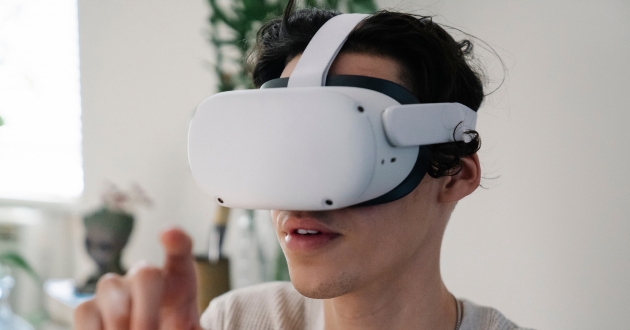Virtual reality headsets for gaming are revolutionizing the way players experience digital worlds. No longer are gamers limited to two-dimensional screens; instead, they are fully immersed in highly interactive.
The growing popularity of virtual reality headsets for gaming can be attributed to technological advancements and the increasing demand for more immersive entertainment.
While the benefits of virtual reality headsets for gaming are undeniable, it’s important to recognize the challenges and limitations that come with this technology. Issues such as motion sickness, high costs, and the need for powerful hardware can present barriers for some users.
Innovations in Virtual Reality Technology

Recent innovations in virtual reality technology are significantly enhancing the gaming experience.
One of the major players in the VR space, Meta, has been leading the charge with cutting-edge VR headsets that push the boundaries of immersion and interactivity.
Their latest devices provide more precise tracking, improved display resolutions, and greater comfort, making them a popular choice among gamers.
For more information on their latest VR offerings, you can explore their official website at Meta. These advancements are shaping the future of how players engage with virtual worlds.
Advantages of Virtual Reality Headsets in Gaming
1. Immersive Experience
One of the primary advantages of virtual reality headsets is the unparalleled immersive experience they provide.
Gamers can fully enter the game world, with their head movements controlling the camera and perspective.
This immersion creates a strong sense of presence, making the player feel as though they are physically inside the game.
2. Enhanced Realism and Interactivity
VR headsets allow for enhanced realism and interactivity. Players can manipulate objects, interact with the environment, and even engage with other players in ways that traditional gaming setups cannot offer.
This level of interactivity leads to deeper engagement and a more dynamic gaming experience.
Challenges in Virtual Reality Gaming
1. High Cost of Entry
While VR gaming offers an exciting experience, the cost of purchasing a high-quality VR headset, along with the necessary hardware, can be prohibitive. Many VR systems require powerful PCs or consoles to run smoothly, which can drive up the overall investment.
2. Physical Discomfort
For some players, VR gaming can lead to physical discomfort, such as motion sickness or eye strain.
These issues are usually related to the headset’s display and how the brain processes virtual movements versus actual movements, but they can detract from the gaming experience.
Future of Virtual Reality in Gaming
1. Technological Advancements
As technology evolves, we can expect significant improvements in the quality and affordability of VR headsets.
Lighter designs, higher resolutions, and better tracking will make virtual reality gaming more comfortable and accessible to a broader audience.
2. Expanding Game Libraries
With more developers creating VR-specific games, the library of available titles is growing rapidly.
This expansion will provide gamers with more diverse and innovative experiences, ensuring that VR remains a strong force in the gaming industry.
The Role of Artificial Intelligence in Gaming
Artificial intelligence (AI) is playing an increasingly important role in gaming, particularly in enhancing the realism and responsiveness of virtual reality environments.
AI can help create more adaptive and intelligent non-player characters (NPCs) that respond to players’ actions in a natural and realistic way.
This integration of AI and VR technology is opening new doors for more immersive and dynamic gaming experiences.
Moreover, AI is also becoming a crucial tool for small game developers to streamline processes, reduce development time, and create smarter in-game systems.
For those exploring how AI can support their gaming projects or small business, it’s worth checking out the best artificial intelligence tools for small businesses that are driving innovation across industries.
FAQ: Virtual Reality Headsets for Gaming
1. What are the best virtual reality headsets for gaming?
The best virtual reality headsets for gaming include models like the Meta Quest 3, PlayStation VR2, and Valve Index. Each of these headsets offers unique features such as high-resolution displays, responsive tracking, and wide game libraries. The right choice depends on your platform preference (PC, console, or standalone) and budget.
2. Do I need a powerful PC to use virtual reality headsets for gaming?
Some VR headsets require a powerful gaming PC to run, like the Valve Index and Oculus Rift S. However, standalone headsets like the Meta Quest 3 don’t need a PC and can run games directly on the device. Additionally, certain PC-tethered headsets can also leverage cloud gaming services, reducing the need for high-end hardware.
3. Can virtual reality headsets cause motion sickness?
Yes, some players may experience motion sickness when using VR headsets, especially during fast-paced or movement-heavy games. However, many VR systems have implemented features such as adjustable frame rates and field of view settings to reduce these effects. Getting used to VR over time can also help minimize discomfort.
4. Are virtual reality headsets worth the investment for gaming?
For many gamers, virtual reality headsets are worth the investment due to the immersive and interactive experience they offer. While they can be expensive, the unique gameplay, combined with growing libraries of VR-specific titles, make them a compelling choice for those looking for a new way to experience games.
5. What types of games can I play on virtual reality headsets?
Virtual reality headsets for gaming offer a wide range of genres, including first-person shooters, puzzle games, role-playing games, and fitness experiences. Popular VR games include titles like Beat Saber, Half-Life: Alyx, and The Walking Dead: Saints & Sinners.
6. How much space do I need to play VR games?
The space required for VR gaming depends on the headset and the games being played. Many VR games work in small spaces, but room-scale VR experiences may require an area of around 2×2 meters to move freely. It’s important to clear the play area of obstacles to avoid accidents.
7. Can I use virtual reality headsets for gaming with glasses?
Most virtual reality headsets are designed to accommodate glasses, though comfort can vary. Some headsets allow for lens adjustments or offer prescription lens adapters to make the experience more comfortable for those who wear glasses.
Conclusion
In conclusion, virtual reality headsets for gaming have brought a new level of immersion and interactivity to the gaming world. With the ability to fully transport players into virtual environments, VR gaming offers experiences that traditional gaming cannot match.
While there are still challenges, such as the cost of entry and potential motion sickness, ongoing improvements in hardware and game development are making VR more accessible and enjoyable for a wider audience.
As the gaming industry continues to evolve, virtual reality headsets are likely to play a major role in shaping its future. Whether for casual gamers or serious enthusiasts, VR offers a unique and captivating way to experience games, creating deeper connections with both the virtual worlds and other players.


